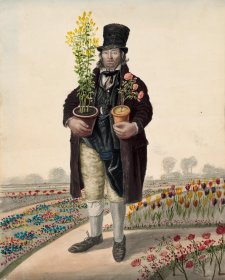In the early 19th century, a combination of concentration of population, diversification of business, expansion of markets, increased literacy and improved printing technology created the new phenomenon of street advertising. The bellman and criers of previous centuries began to be replaced by an army of ‘standard bearers’ or sandwich men and billposters.
William Pyne included a bill-sticker with paste pot, brush and squeegee in his Costume of Great Britain, accompanied by a characteristically enthusiastic text:
Within six hours, by the means of printed bills, the inhabitants of a great city can be advertised of a thousand things necessary to be publicly known; and in cases of fugitive robbers, traitors, spies, &c. the Hue and Cry, or notice for their apprehension, is circulated throughout the kingdom in four or five days.
The exertions that characterise the dashing spirit of the times, is visible in the printing of bills; every day some new mode of catching the attention of the passing multitude is resorted to; witness the bills six or eight feet long, stuck upon the walls to announce the exhibitions at our Amphitheatres, Circus’s [sic] … &c. &c. Surely, the printers of the nineteenth century have proved, that ‘those who run may read’.
Dempsey’s folio includes the old and the new, both bellmen and billmen. Of the latter, one named Cary, of Great Yarmouth in Norfolk. Posed in front of an awkwardly drawn perspective of terrace houses and cobbled road, Cary is crossing the street while his handiwork is being considered by a passer-by in the right middle distance. Like Pyne’s billsticker, he wears ordinary street clothes, solving the problem of a threehanded job by hanging the glue pot around his neck.
Dempsey’s other billposter takes a different approach: he holds the bucket in his hand, but wears a protective smock, hitched up and belted to make an apron/pocket for the bills. With one hand on his squeegeespear and his weight carried on one leg in the so-called chiastic pose, this character carries faint, odd, perhaps ridiculous, echoes of classical statuary, specifically the Doryphoros of Polykleitos.
Unfortunately, the paper has been trimmed at some time in the past and an inscription has been bleached or erased. This billman has neither name nor home. Dated 1825, the year of the artist’s northern tour (other 1825 portraits are from Yorkshire and Sunderland) this work may be from somewhere in East Anglia; the red and white poster in the top right is an advertisement for the horse races at Newmarket, on the Suffolk– Cambridgeshire border.
Collection: Tasmanian Museum and Art Gallery, presented by C. Docker, 1956



Dempsey’s people: a folio of British street portraits 1824–1844 is the first exhibition to showcase the compelling watercolour images of English street people made by the itinerant English painter John Dempsey throughout the first half of the nineteenth century.



Visit us, learn with us, support us or work with us! Here’s a range of information about planning your visit, our history and more!



We depend on your support to keep creating our programs, exhibitions, publications and building the amazing portrait collection!